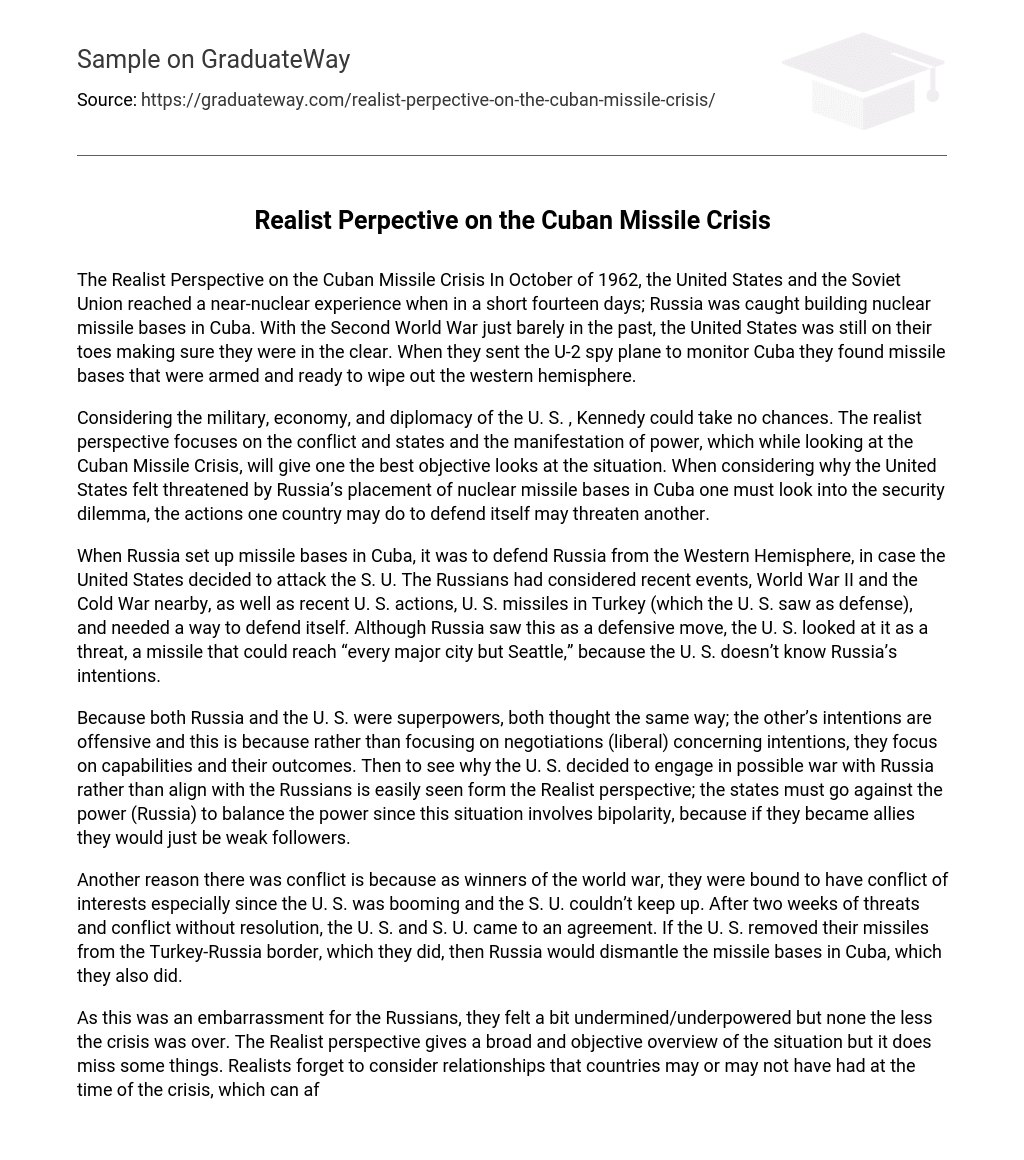The Realist Perspective on the Cuban Missile Crisis
In October 1962, the United States and the Soviet Union nearly engaged in a nuclear standoff. Within just two weeks, it was discovered that the Soviet Union had been constructing nuclear missile bases in Cuba. The United States, having learned from the lessons of World War II, remained watchful in protecting its security. A U-2 spy plane was dispatched to surveil Cuba, revealing the existence of armed missile bases that posed a significant threat not only to America but also to the entire western hemisphere.
Kennedy had to be cautious in the military, economy, and diplomacy of the U.S. to reduce risks. The realist perspective stresses state conflict and power projection. Analyzing the Cuban Missile Crisis can provide a fairer comprehension of the situation. To understand why the United States perceived Russia’s creation of nuclear missile bases in Cuba as a threat, it is important to take into account the security dilemma, which occurs when defensive measures taken by one country may be seen as a threat by another.
Russia established missile bases in Cuba as a defensive measure to protect against potential attacks by the United States in the Western Hemisphere. This decision was influenced by historical events such as World War II and the Cold War, along with the presence of American missiles in Turkey (which were seen as defensive by the US). Russia saw this action as necessary for its defense, while the United States viewed it as a threat. The US had concerns that these missiles could potentially target all major cities except Seattle due to uncertainty about Russia’s intentions.
Both Russia and the U. S. thought alike as they were both superpowers, perceiving each other’s intentions as offensive. Instead of concentrating on negotiations regarding intentions, they prioritized capabilities and their consequences. The Realist perspective clarifies why the U. S. opted for potential conflict with Russia rather than forming an alliance with them; in order to maintain a balance of power, states must resist opposing powers (such as Russia) when facing bipolar situations, as becoming allies would only result in weakness and subservience.
Conflict arose due to the winners of the world war having conflicting interests, particularly because of the U.S.’s flourishing economy contrasting with the Soviet Union’s inability to keep up. After two weeks of unresolved threats and conflict, both nations reached an agreement. The U.S. complied by removing their missiles from the border of Turkey and Russia, while Russia reciprocated by dismantling their missile bases in Cuba.
The crisis caused embarrassment for the Russians, making them feel undermined or underpowered. However, it eventually ended. The Realist perspective provides a comprehensive and unbiased analysis of the situation, although it overlooks certain aspects. Realists fail to consider the relationships between countries during the crisis, which can have significant implications. They do not acknowledge that Russia and the U.S. were not allies, causing Russia to believe it had to establish missile bases in Cuba as retaliation against potential threats from the U.S.
S. perceived the situation as being focused on capabilities instead of intentions due to the lack of communication between the U.S. and S.U. Both countries had self-interested objectives aimed at their own defense, without considering the potential alignment of their intentions. It is uncertain if they could have reached an agreement if they had comprehended each other’s desires. Realists credit Kennedy’s diplomatic efforts for resolving the situation, while a liberalist might argue that the presence of nuclear weapons, just a finger’s length away from the opposing country, played a significant role.
If both countries had taken a liberal perspective, they would have seen the potential for trade and weapon control, leading to a departure from a zero-sum mindset (Nau, Lecture). Additionally, the US was displeased with the Soviet Union’s communist government, as it contrasted with their democratic system. Without a shared understanding to bridge their differences, the full significance of their philosophies remained incomprehensible.
The Realism perspective, which the liberal and Identity perspectives also focus on, highlights the communication and relationship issues that led to this crisis. In summary, although the realist perspective overlooks some key aspects, it provides valuable insights and presents both leaders’ viewpoints on the Cuban Missile Crisis.





